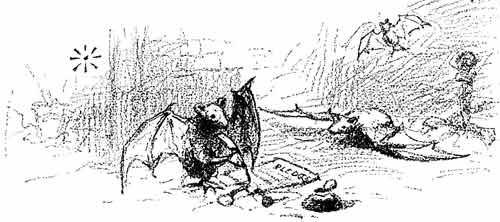|

Small-headed: The skull of the Bumblebee bat, at 11 mm, is smaller than that of any other mammal. The "Bumblebee" appellation derives from the bats' comparative size to the insect it is named after. Bumblebee bats compete with the Etruscan Pygmy shrew for the title of world's smallest mammal. At issue is whether skull size or mass defines "smallest"; the shrew is lighter but the bat's skull is shorter at 11 mm.
Big Ears: The Bumblebee bat has reddish-brown upperparts, although the species seems to occur as another color phase that has grayer upperparts. The underside is always a paler version of the top. The ears are relatively large and extend beyond the rather pig-like snout when lying forward.

The Bat Flies at Dusk: They are most active at dusk when they fly around the tops of bamboo clumps and teak trees to feed on insects. The wings are quite long and broad with pointed tips and dark membrane. They seem to be shaped for hovering flight and indeed gut contents of specimens do include spiders as well as small insects that have been gleaned off foliage. The Bumblebee bat also catches insects in flight.
Cozy Roost: Bumblebee bats roost in the hot upper chambers of caves in limestone hills, just about as far away from the entrance as possible so that the small colony — up to 15 individuals — can fit without the bats being too close to each other.

A New Discovery: Bumblebee bats are small both in size and in number and were unknown to the world at large prior to 1974. They were first located in 1973 by Thai biologist Kitti Thonglongya, who sent a few specimens to his British colleague, John E. Hill. When Kitti Thonglongya died suddenly in February 1974, John Hill described the species and named it in honor of its discoverer.
Populations Dropping: Their already restricted habitat has been highly affected by deforestation and unsustainable levels of teak logging. In 1982, the Royal Forest Department of the Thailand Government only found 160 of them living in 3 caves, despite extensive surveys. Bumblebee bats are now considered to be one of the twelve most endangered species on the planet.

All text is available under the terms
of the GNU Free Documentation License
|